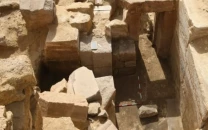13-billion-year-old galaxy cluster discovered
Discovery of protocluster suggests that large cosmic structures were present in very early stages of universe

This artist's impression of the formation of a galaxy cluster in the early universe was released in 2014 as a handout by the European Southern Observatory. PHOTO: AFP/FILE
Such an early-stage cluster - called a protocluster -- is "not easy to find", Yuichi Harikane, a researcher at the National Astronomical Observatory of Japan who led the international team, said in a press release.
"A protocluster is a rare and special system with an extremely high density," Harikane said, adding that the researchers used the wide viewing field of the Subaru telescope in Hawaii to 'map a large area of the sky' in their search.
Distant asteroid calamity shaped life on Earth 466 million years ago
The discovery of the protocluster, a collection of 12 galaxies, suggests that large cosmic structures were present in the very early stages of the universe, which scientists believe was born 13.8 billion years ago.
One of the 12 galaxies is known as Himiko, a giant gas cloud found in 2009 by using the same telescope.
Newfound comet likely an 'interstellar visitor,' scientists say
"It is reasonable to find a protocluster near a massive object, such as Himiko. However, we're surprised to see that Himiko was located... on the edge 500 million light-years away from the center," the paper's co-author Masami Ouchi said.
"It is still not understood why Himiko is not located in the centre," he said.
"These results will be key for understanding the relationship between clusters and massive galaxies."
The team included scientists from Imperial College London and the study is published in Friday's Astrophysical Journal.



















COMMENTS
Comments are moderated and generally will be posted if they are on-topic and not abusive.
For more information, please see our Comments FAQ